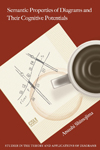
Semantic Properties of Diagrams and Their Cognitive Potentials
Atsushi Shimojima
Why are diagrams sometimes so useful, facilitating our understanding and thinking, while at other times they can be unhelpful and even misleading? Drawing on a comprehensive survey of modern research in philosophy, logic, artificial intelligence, cognitive psychology, and graphic design, Semantic Properties of Diagrams and Their Cognitive Potentials reveals the systematic reasons for this dichotomy, showing that the cognitive functions of diagrams are rooted in the characteristic ways they carry information. In analyzing the logical mechanisms behind the relative efficacy of diagrammatic representation, Atsushi Shimojima provides deep insight into the crucial question: What makes a diagram a diagram?
“Semantic Properties of Diagrams and Their Cognitive Potentials is a most welcome book that brings together the author's various contributions to a ‘science of diagrams’ into one place under a clear, coherent, and unifying presentation. The book is likely to attract a wide readership among all the academic fields that contribute to the diagrams area. The first step towards a logical foundation for a science of diagrams is an important contribution to an area that continues to be of growing interest among many disciplines. Many potential readers will be interested in the question of what makes an effective representation or why are diagrams often more effective than sentential representations.”
—Peter Cheng, University of Sussex
Atsushi Shimojima is professor in the Faculty of Culture and Information Science at Doshisha University, Japan.
- 1 Introduction
- 1.1 General Problem
- 1.2 Origin of This Book
- 1.3 Main Theme 1: Free Rides
- 1.4 Main Theme 2: Over‐Specify
- 1.5 Main Theme 3: Consistency Check
- 1.6 Main Theme 4: Derivitive Meaning
- 1.7 Organization of This Book
- 1.8 The Reach of This Book
- 2 Potential for Ride in Inference
- 2.1 The Phenomenon
- 2.1.1 Hohauser (1982): Memory Maps
- 2.1.2 Barwise & Etchemendy (1991): Hyperproof Diagrams
- 2.1.3 Funt (1980): Block Drawings
- 2.1.4 Larkin & Simon (1987): Geometry Diagrams
- 2.1.5 Schön (1983): Design Sketches
- 2.1.6 Further Examples: Venn Diagrams
- 2.1.7 Further Examples: Euler Diagrams
- 2.2 General Framework for Analysis
- 2.2.1 Representation and Source Types
- 2.2.2 The Representation Relation
- 2.2.3 Represented Objects and Target Types
- 2.2.4 The Indication Relation
- 2.2.5 Two‐Tier Semantics
- 2.2.6 Constraints
- 2.3 Analysis
- 2.3.1 Consequence Tracking
- 2.3.2 Application of the Notion to Specific Examples
- 2.4 Questions and Responses
- 2.4.1 Question: Who Does the Inference, Then?
- 2.4.2 Question: Is It Really Free?
- 2.4.3 Question: Is It Always Advantageous?
- 2.4.4 Question: Possibility of Invalid Rides?
- 2.5 Chapter Takeaways
- 3 Potential of Over‐Specificity
- 3.1 The Phenomenon
- 3.1.1 Hohauser (1982): Memory Maps
- 3.1.2 Barwise & Etchemendy (1994): Hyperproof Diagrams
- 3.1.3 Barwise & Etchemendy (1991): Geometry Diagrams
- 3.1.4 Further Examples: Euler Diagrams (Case 1)
- 3.1.5 Further Examples: Euler Diagrams (Case 2)
- 3.2 Analysis
- 3.2.1 Projection of Disjunctive Constraints
- 3.2.2 Applications of the Notion to Specific Examples
- 3.3 Questions and Responses
- 3.3.1 Question: Isn’t It an Artifact?
- 3.3.2 Question: Are Free Rides and Over‐Specificity So Different?
- 3.4 Chapter Takeaways
- 4 Potential for Consistency‐Check
- 4.1 The Phenomenon
- 4.1.1 Schön (1983): Cross‐Section Diagrams
- 4.1.2 Barwise & Etchemendy (1994): Hyperproof Diagrams
- 4.1.3 Galernter (1959): Geometry Diagrams
- 4.1.4 Barwise & Etchemendy (1995): Euler Diagrams
- 4.1.5 Further Examples: Charts
- 4.2 Analysis
- 4.2.1 Inconsistency Tracking
- 4.2.2 Applications to Specific Goals
- 4.3 Questions and Responses
- 4.3.1 Question: Are They Really Auto‐Consistent?
- 4.3.2 Question: Differnce from the Standard Counter‐Example Method?
- 4.3.3 Question: Unsoundness in Inconsistency?
- 4.3.4 Question: Diagrammatic Proof of Inconsistency?
- 4.4 Chapter Takeaways
- 5 Potential for Derivative Meaning
- 5.1 The Phenomenon
- 5.1.1 Tufte (1983): Scatter Plots
- 5.1.2 Kosslyn (1995): Line Graphs
- 5.1.3 Pinker (1990): Bar Graph
- 5.1.4 Kinnear and Wood (1997): Contour Maps
- 5.1.5 Olivier (2001): Node‐Edge Graphs
- 5.1.6 Further Examples: Round‐Robin Tables
- 5.2 Analysis
- 5.2.1 Abstraction Tracking
- 5.2.2 Applications to Specific Cases
- 5.3 Questions and Responses
- 5.3.1 Question: Differences from Secondary Notations?
- 5.3.2 Question: Difference from Graphical Implicatures?
- 5.3.3 Question: Relevance to Cognitive Potentials?
- 5.3.4 Question: Too Many Cases of Abstraction Tracking?
- 5.4 Chapter Takeaways
- 6 Extending the Analysis
- 6.1 Envisaging
- 6.2 Transfer of Spatial Analysis
- 6.3 Aspect Shifting
- 6.4 Law‐Encoding Diagrams
- 6.5 Chapter Takeaways
- 7 Conclusion: Diagrams as the Subject of Scientific Studies
- 7.1 Commonality of the Four Logical Properties
- 7.2 Implications of the Commonality
- Appendix A: Additional Analysis of Free Ride Potentials
- Appendix B: Analysis of a Derivative Meaning with Round‐Robin Tables
- References
- Index
November 2015
ISBN (Paperback): 1575868490 (9781575868493)
|



Distributed by the
University of
Chicago Press
|


